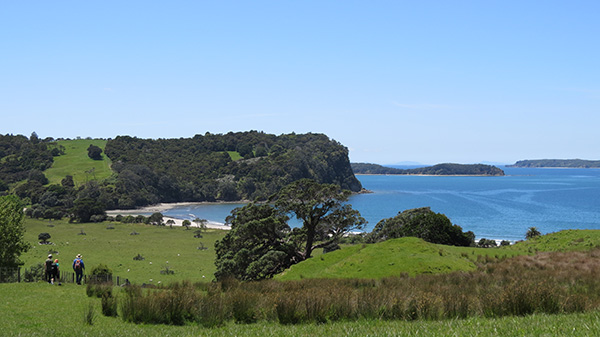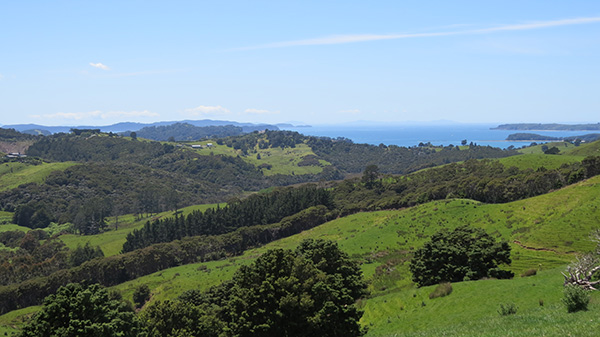Disdaining community input council plans new group

Heading for the Beach: While the 407-hectare Schischka farm bought for $15 million is a magnificent addition to the greater Mahurangi regional park estate, it is just 12 or so hectares of the original 1973 acquisition of the coastal margins of Te Muri that will bear the heaviest impact by park visitors. This is why the coastal flats must by prioritised for camping and picnicking, not car parking, and provided as the reward for visitors who are prepared to undertake a twenty-minute walk to reach this prime regional parkland. image Mahurangi Magazine
Simultaneously, it’s one of the best and the most preposterous proposals of the draft plan:
Establish a friends group for the park and wider network of Mahurangi regional parks.
Preposterous because, having relegated the concept most widely supported by community groups—the proposed Mahurangi Coastal Trail as the primary means of access to Te Muri—behind a slew of vehicular access priorities, the draft regional parks management plan proposes to establish a friends group that presumably would be listened to.
Best because, the desirability of a friends group for Te Muri, and preferably the greater Mahurangi regional park, is axiomatic. However, the prerogative for forming a friends group is entirely that of regional parks users. It is troubling that parks officers are sufficiently oblivious of who enjoys that prerogative to have not said:
Encourage the community to establish a friends group for the park, or the wider network of Mahurangi regional parks.
Friends groups are an essential means for users to contribute to the health of regional parks, whether by assisting with pest control, track building, tree planting or helping to shape policy. But in respect to shaping policy, such as in the current process of reviewing the Auckland Regional Parks management plan to include the 2010 acquisition of the 407-hectare Schischka farm, council officers have presumed to know what is best for Aucklanders and effectively categorised the community’s input as parochial.
Many organisations have submitted to this current process, including Friends of Regional Parks and Mahurangi Action, so some might question whether a new group is required. However, as its full name suggests, Friends of Regional Parks (Auckland) Incorporated is concerned with the entire Auckland Regional Parks network and its interests would be too broad for many Mahurangi and Te Muri regional park users to be motivated to become members. Meantime, Mahurangi Action, also an incorporated society, has the local focus, but its interests extend far beyond even the boundaries of the greater Mahurangi regional park network, notably to include the entire Mahurangi hydrological catchment, given the battle to address the harbour’s elevated sediment accumulation rate. Again, its interests are likely too broad for many potential members of a Te Muri or greater Mahurangi regional park users association. And then there’s the newly incorporated Mahurangi Coastal Trail Trust, but its mandate is to advance the proposed trail, including by raising most of the funds required to construct the Judge Arnold Turner Footbridge, the only potentially contentious component of the concept.

Missing Te Araroa Link: The highest value use of the 407-hectare of hill country purchased in in 2010 is as part of Te Araroa, the national walkway, connecting Pūhoi and Wenderholm, via Te Muri and the proposed Mahurangi Coastal Trail. While the numbers of Te Araroa through-walkers currently only number in the hundreds per year, the rate is increasing exponentially. Once it is opened, provided the opportunity is not squandered by opening the road to private cars, many, many times more people will walk the sublime route, as a two-and-a-half hour day trip, than will ever walk from North Cape to Bluff. image Mahurangi Magazine
One of the challenges in establishing a new users association will be whether it focusses tightly on Te Muri, or on the greater Mahurangi regional park. There is no right answer, except that the interests of Te Muri can only be well served if its users association thinks and acts as though Te Muri, as magnificent an entity as it is, is part of an even more magnificent entity, the greater Mahurangi regional park, and likewise it is part of the incomparable Auckland Regional Parks network. The draft plan, to its credit, signals this need when it proposes a users association:
for [Te Muri] and the wider network of Mahurangi regional parks.
Currently, while Wenderholm has a strong group of volunteers, and there is a Friends of Couldrey House, there is no Wenderholm users association. Similarly, but on a smaller scale, the Mahurangi Regional Park has volunteers but no association. It is clear that, whether with one entity, with branches or subcommittees, or with several entities, the interests of the whole magnificent 900-hectare regional parkland estate and of its component parks, at least one park association is needed. The pros of greater autonomy need to be weighed against the cons of potentially weaker bodies, each with their own administrative overheads. For example, one license for the much vaunted Xero accounting software shared between three branches would cost each a mere $6.25 per month, and would enormously improve the prospects of attracting a treasurer.
The first question to settle is whether this should be a council initiative, or a council-supported initiative.
